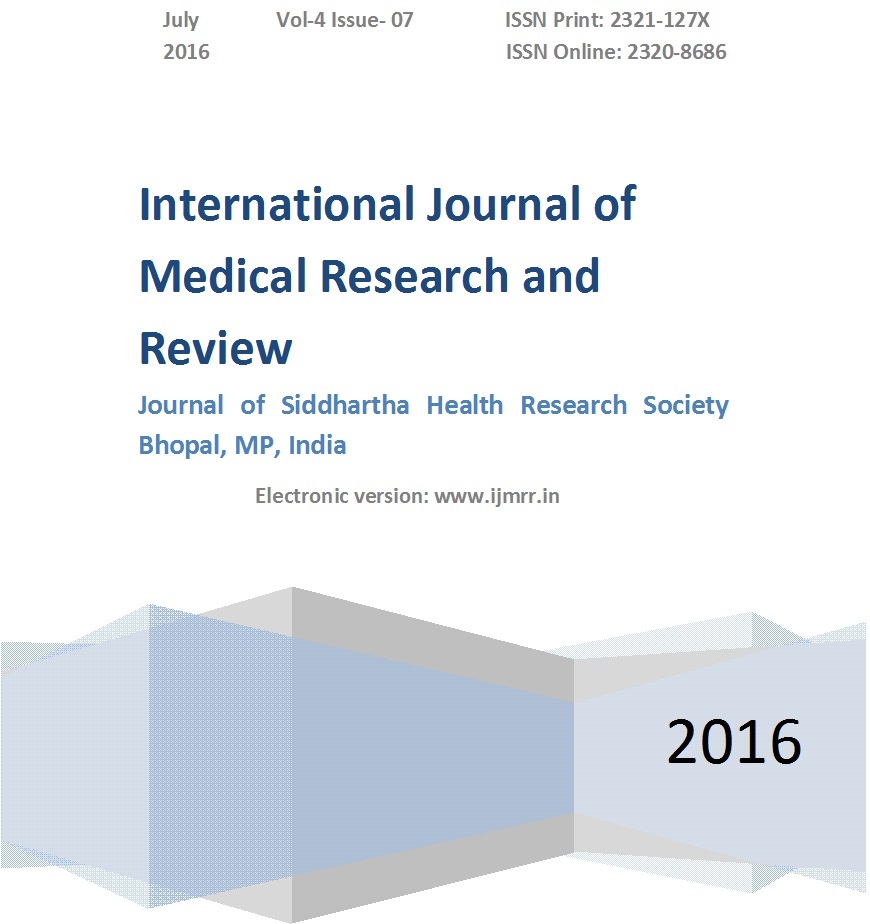A study of percutaneous k-wire fixation of supracondylar fracture in children in a tertiary care institute
Abstract
Introduction: In orthopaedics practice Supracondylar fracture of humerus is the commonest injury around elbow in children during fall on the outstretched hand. The complications of this injury are many like pain, deformity and permanent restriction of movement however if due care is taken and early treatment is started, excellent results are seen. Various treatment modalities are used for treating these fractures. Closed reduction and percutaneous pinning is a useful technique to manage this condition.
Methods: Thirty five cases with Gartland type III supracondylar humeral fractures were treated with closed reduction and percutaneous lateral pin fixation with Kirschner wire and followed up for 12 months.
Results: Results were excellent in 30 patients and good in 4 patients according to Flynn’s criteria. There was only one patient with poor results. Post-operatively, one patient sustained ulnar nerve injury. Two patients got pin tract infection which were superficial and healed after removing pins and antibiotics. Union was seen in all patients at the 2-3 weeks post-operatively before removing the K-wires.
Conclusion: It is concluded that closed reduction and lateral pin fixation is a safe and effective treatment modality for management of supracondylar fractures with minimum complication rate.
Downloads
References
Weiland AJ, Meyer S, Tolo VT, Berg HL, Mueller J. Surgical treatment of displaced supracondylar fractures of the humerus in children. Analysis of fifty-two cases followed for five to fifteen years. J Bone Joint Surg Am. 1978;60(5):657-61.https://journals.lww.com/jbjsjournal/Abstract/1978/60050/Surgical_treatment_of_displaced_supracondylar.12.aspx.
Flynn JC. Mathews JG, Benoit RL. “Blind pinning of displaced supracondylar fractures of the humerus in children”. J Bone & Joint Surg (Am),/974;56A: 263-272.
Ariño VL, Lluch EE, Ramirez AM, Ferrer J, Rodriguez L, Baixauli F. Percutaneous fixation of supracondylar fractures of the humerus in children. J Bone Joint Surg Am. 1977 Oct;59(7):914-6.https://journals.lww.com/jbjsjournal/Abstract/1977/59070/Percutaneous_fixation_of_supracondylar_fractures.13.aspx.
Kaewpornsawan K. Comparison between closed reduction with percutaneous pinning and open reduction with pinning in children with closed totally displaced supracondylar humeral fractures: a randomized controlled trial. J PediatrOrthop B 2001;10:131–7.https://journals.lww.com/jpo-b/Abstract/2001/10020/Comparison_Between_Closed_Reduction_with.10.aspx.
Boyd DW, Aronson DD. Supracondylar fractures of the humerus: a prospective study of percutaneous pinning. J Pediatr Orthop 1992;12: 789–94.doi: https://doi.org/10.1097/01241398-199211000-00017.
Gartland JJ. Management of supracondylar fractures of the humerus in children. Surg Gynecol Obstet. 1959;109:145–54.
Cheng JC, Lam TP, Shen WY. Closed reduction and percutaneous pinning for type III displaced supracondylar fractures of the humerus in children. J Orthop Trauma 1995; 9(6): 511-515.doi: https://doi.org/10.1097/00005131-199509060-00009.
Ating’a JE. Conservative management of supracondylar fractures of the humerus in Eastern Provincial General Hospital, Machakos. East Afr Med J 1984;61:557–60
Edward E, Palmar, et al. Supracondylar fractures of the humerus. In children. JBJS 1978;60-A:652.
Farnsworth CL, Silva PD, Mubarak SJ. Etiology of supracondylar humerus fractures. J PediatrOrthop 1998;18(1):38-42.
Mostafavi HR. and Spero C. “Crossed pin fixation of displaced supracondylar humerus fractures in children”. ClinOrthop, 2000; 376; 56-61.doi: https://doi.org/10.1097/00003086-200007000-00009.
Davis RT, Gorczyca JT, Pugh K. Supracondylar humerus fractures in children. Comparison of operative treatment methods. ClinOrthop Relat Res 2000; (376): 49-55.
Kumar R, Kiran EK, Malhotra R, Bhan S. Surgical management of the severely displaced supracondylar fracture of the humerus in children. Injury 2002;33(6):517-22.doi: https://doi.org/10.1016/s0020-1383(02)00031-1.
Royce RO, Dutkowsky JP, Kasser JR, et al. Neurologic complications after K-wire fixation of supracondylar humerus fractures in children. J PediatrOrthop 1991; 11 (2): 191-94.



 OAI - Open Archives Initiative
OAI - Open Archives Initiative


